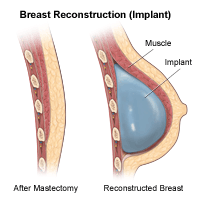Breast Reconstruction
What is breast reconstruction?
With advances in breast reconstruction surgery, many women undergoing breast removal (mastectomy) choose to have their breast(s) rebuilt. Even though medical, surgical, and radiation therapy treatments for breast cancer have increased the number of breast-sparing procedures available, some breast cancer patients may still need a mastectomy. In addition, other women have their breast(s) removed due to other diseases.
Breast reconstruction involves creating a breast mound that comes as close as possible to the form and appearance of the natural breast.
The goal of reconstructive surgery is to create a breast mound that matches the opposite breast and to achieve symmetry. If both breasts have been removed, the goal of breast reconstructive surgery is to create both breast mounds about the size of the patient's natural breasts.
What are the criteria for breast reconstruction?
In general, all women undergoing a mastectomy are candidates for immediate or delayed breast reconstruction. However, there are criteria for selecting the best candidates for the procedure:
-
The size and location of the cancer, which determines the amount of skin and tissue to be removed in the mastectomy, are primary factors when making recommendations for reconstruction.
-
Whether tissue has been damaged by radiation therapy or aging, and is not healthy enough to withstand surgery.
-
Other considerations include:
-
Potential for complications
-
Patient's desires
-
The amount of tissue removed from the breast
-
The health of the tissue at the planned operation site
-
Whether radiation therapy is part of treatment
-
The patient's general health and physique
-
Past medical history
-
Other illnesses
-
Other risk factors, such as cardiac disease, diabetes mellitus, smoking, and obesity
When is breast reconstruction performed?
The patient is usually educated and counseled in breast reconstructive options prior to mastectomy, so that she can make the decision for or against reconstruction before going into surgery. Based on the personal medical history of each patient, a recommendation will be made for either:
-
Immediate reconstruction. Reconstructive surgery performed at the same time as mastectomy.
-
Delayed reconstruction. A second operation (to reconstruct missing breast tissue) is performed after recovery from the mastectomy is complete. If radiation therapy is part of the treatment protocol, the surgeon may recommend waiting to do reconstruction after the radiation is finished.
What complications are commonly associated with breast reconstruction?
Any type of surgery carries some risk. Patients differ in their anatomy and their ability to heal. Some complications from breast reconstruction may include:
The most common complication of breast reconstruction done with implants is capsular contracture, which occurs if the scar or capsule around the implant begins to tighten. Occasionally, this (and other) complications are severe enough to require a second operation.
What are the different types of breast reconstruction?

The 2 most effective approaches available for both unilateral (1 breast) and bilateral (both breasts) reconstruction are:
-
Expander/implant reconstruction. The use of an expander to create a breast mound, which may be followed by the placement of a permanently filled breast implant.Expanders are empty silicone "envelopes" placed under the pectoralis muscle, located between the breast and the chest wall. To enable the skin and soft tissues of the breast to grow, the expander is gradually filled with saline solution over a period of several weeks. The saline is injected into the expander through a valve or port in the expander that lies just under the skin. Once the expander has been completely filled, it is left in for several more weeks to months, allowing for maximal skin and soft tissue growth.Implants are envelopes filled with liquid that are implanted into the breast tissue and are used to form the shape of the breast. Implants may be filled with saline or silicone gel. Each type of implant has advantages and disadvantages. Your doctor will discuss the types of implants with you and seek your input about the type of implant to be used.
-
Autologous tissue reconstruction. The use of the patient's own tissues to reconstruct a new breast mound. The common technique is the TRAM (transverse rectus abdominous muscle) flap. A TRAM flap involves removing an area of fat, skin, and muscle from the abdomen (belly) and moving it to the chest.
About the procedure:
© 2000-2024 The StayWell Company, LLC. All rights reserved. This information is not intended as a substitute for professional medical care. Always follow your healthcare professional's instructions.